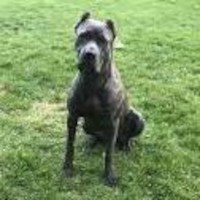Appearance of the Cane Corxer
|
| The Cane Corxer hybrid can take on the appearance traits of one or both of its parent breeds. The coat may be short, elegant and easy to care for, or double-coated, with the outer coat short, glossy and coarse, and the undercoat soft and light. The hybrid's body will be muscular and strong, with proportionate size and weight. Size will be determined by the dominant parent breed in the gene pool. Facial expression will be watchful with combined eye shape and size, eye positioning and forehead crease, which is similar in both parent breeds. The eyes will be dark and may be round or almond-shaped with dark rims. The ears of both parent breeds are usually cropped, but if not cultivated, they hang close to the cheeks. The muzzles of both breed parents are of equal proportion, with an underbite being larger in the Boxer parent than in the Corso parent. The paws are likely to be round and compact, with well arched toes. The tail can be of various lengths. The coat may be smooth and dense or double-coated, depending on the dominant breed parent, and may be black, gray, fawn, red, brindle, blue and brown with white markings. |
Temperament of the Cane Corxer
|
| The Cane Corxer can take on the temperament traits of one or both of the breed's parents. These include alertness, cheerfulness, courage, intelligence, energy, kindness, loyalty, sociability, outgoing, playful and calm. The Corso parent can be quite dominant and will add a great deal of independence to the gene pool, making it imperative that the responsible entity be established from the outset for a successful relationship. The Corso parent also contributes to gentleness and stability if the dog is properly socialized and trained early enough. The breed will bond with family members and be very protective of family and possessions, but wary of strangers, seeming to have heightened feelings when something goes wrong. Both parent breeds are highly intelligent and, although sometimes stubborn, can be easily trained if appropriate positive training and discipline methods are used. They may not get along with other animals, given their hunting heritage. Because of the Corso's organic influence, the Cane Corxer may do best in a home where it is the only dog. |
Needs and activities of the Cane Corxer
|
| The mature Cane Corxer will probably require 1 to 2 hours of daily exercise, which may take the form of daily walks, agility games, retrieving, Frisbee and obedience. The Cane Corxer is a relatively active hybrid, but will do well in an apartment or house with a well-secured fenced yard where he can run, romp and play. Apartment dwellers will need to walk and exercise him appropriately to avoid the destructive behaviors that can develop. Both parent breeds will bond with family members, so they do best when not left alone for long periods. They can live in urban or rural environments, but can do best when not exposed to extreme temperatures. |
Maintenance of the Cane Corxer
|
| Both parent breeds provide coats that are moderate excretors but are relatively smooth and dense, requiring little maintenance, which essentially amounts to weekly brushing to keep the coat clean and free of debris. Shampooing or bathing the Cane Corxer hybrid, like its parent breeds, should only be done if necessary to maintain the oils in the coat. As with almost all canine breeds, regular dental cleaning and examinations will help prevent periodontal disease and the resulting tooth loss. Eye examinations will probably be necessary periodically, as there are a number of eye conditions known to afflict related breeds and will need to be assessed and monitored as your pet ages. Ears should be checked and cleaned weekly or as needed to prevent infection. |









 English (United Kingdom)
English (United Kingdom)